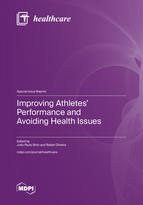Improving Athletes’ Performance and Avoiding Health Issues
A special issue of Healthcare (ISSN 2227-9032).
Deadline for manuscript submissions: closed (28 February 2023) | Viewed by 89098
Special Issue Editors
2. Life Quality Research Center, 2040-413 Rio Maior, Portugal
3. Research Centre in Sport Sciences, Health Sciences and Human Development, 5001-801 Vila Real, Portugal
Interests: exercise physiology; clinical exercise physiology; exercise training programs; well-being, physical activity and healthy lifestyle; assessment of physical capacity; quality of life of subjects with clinical conditions and active lifestyle (elderly, children, type 2 diabetes, Parkinson, etc.); sarcopenia; osteopenia; osteoporosis; fall prevention; body composition; strength and conditioning; soccer training; load monitoring; sports
Special Issues, Collections and Topics in MDPI journals
2. Life Quality Research Center, 2040-413 Rio Maior, Portugal
3. Research Centre in Sport Sciences, Health Sciences and Human Development, 5001-801 Vila Real, Portugal
Interests: exercise physiology; soccer training, well-being, training load; sports; physical activity and healthy lifestyle; exercise training programs; physical capacity; body composition; strength and conditioning
Special Issues, Collections and Topics in MDPI journals
Special Issue Information
Dear Colleagues,
In several elite sports, training and match loads have been assessed over the years. However, only the clubs with the most resources and money are able to apply more valid and reliable tools. For instance, at the regional level, clubs and their coaches do not have sufficient resources to allow them to precisely monitor the training/match load. As an example, elite football generates the most media and commercial attention, but it is in regional football that the greatest number of clubs, players, and coaches are found. Meanwhile, the literature that investigates load monitoring in teams at regional level is sparse. Considering other sports such as futsal, basketball, volleyball, rugby, hockey, handball, and/or others, resources could be equally reduced to apply proper load management. Conducting studies at regional level enables the development of knowledge about this population, promoting the evolution of this sport at all competitive levels which will also contribute to avoid any kind of healthcare issues such to injury or illness.
Therefore, the aim of this Special Issue is to provide information on load monitoring, especially in less resourceful sports, but not only, and to show how several load monitoring tools can be used to avoid healthcare issues. The present Special Issue will accept original research and systematic reviews from all sports. We hypothesize that this Special Issue will generate relevant information for several sports to increase performance levels and to avoid healthcare issues.
Dr. João Brito
Dr. Rafael Oliveira
Guest Editors
Manuscript Submission Information
Manuscripts should be submitted online at www.mdpi.com by registering and logging in to this website. Once you are registered, click here to go to the submission form. Manuscripts can be submitted until the deadline. All submissions that pass pre-check are peer-reviewed. Accepted papers will be published continuously in the journal (as soon as accepted) and will be listed together on the special issue website. Research articles, review articles as well as short communications are invited. For planned papers, a title and short abstract (about 100 words) can be sent to the Editorial Office for announcement on this website.
Submitted manuscripts should not have been published previously, nor be under consideration for publication elsewhere (except conference proceedings papers). All manuscripts are thoroughly refereed through a single-blind peer-review process. A guide for authors and other relevant information for submission of manuscripts is available on the Instructions for Authors page. Healthcare is an international peer-reviewed open access semimonthly journal published by MDPI.
Please visit the Instructions for Authors page before submitting a manuscript. The Article Processing Charge (APC) for publication in this open access journal is 2700 CHF (Swiss Francs). Submitted papers should be well formatted and use good English. Authors may use MDPI's English editing service prior to publication or during author revisions.
Keywords
- fitness
- injury
- illness
- match load
- sports training
- sports performance
- training load
- wellness
- wellbeing








